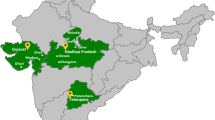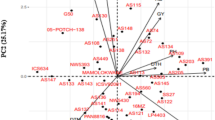Abstract
Sorghum [Sorghum bicolor (L.) Moench] is one of four herbaceous dedicated bioenergy crops the U.S. Department of Energy identified as critical to annually produce one billion tons of dry biomass. Of these four crops, sorghum is unique as it is a drought-tolerant, annual crop established from seed that is readily tractable to genetic improvement. The purpose of this study was to assess the yield potential and stability of sorghums grown across diverse production environments in the USA. For this study, six sorghum genotypes (one cultivar, five hybrids) were grown in yield trials in seven locations in six states for 5 years (2008–2012). Variation in dry and fresh yield was attributable to not only genotypes, but also to the effects of year, location, and year × location. Even with the highest yielding genotype, environmental conditions were a major factor in determining the yield in a given year. This variability affects the consistency of the biomass supply for ethanol production. In general, the southeastern USA had the highest mean yields for fresh weight and dry weight, indicating that this area may be the most reliable for biomass production. A significant variation was detected among genotypes for fresh weight, dry weight, moisture content, and brix, revealing that sufficient variation within sorghum exists for continued improvement and that certain hybrids are more tractable for biomass/bioenergy production. With dedicated bioenergy sorghum germplasm and proper production environments, sorghum will be a valuable tool in the goal of the sustainable production of one billion tons of dry biomass each year in the USA.



Similar content being viewed by others
References
Almodares A, Taheri R, Adeli S (2007) Inter-relationship between growth analysis and carbohydrate contents of sweet sorghum cultivars and lines. J Environ Biol 28:527–531
Bean BW, Baumhardt RL, McCollum FT III, McCuistion KC (2013) Comparison of sorghum classes for grain and forage yield and forage nutritive value. Field Crop Res 142:20–26
Broadhead DM, Zummo N (1983) M 81E sweet sorghum. Crop Sci 23:1013
Burks PS, Felderhoff TJ, Viator HP, Rooney WL (2013) The influence of hybrid maturity and planting date on sweet sorghum productivity during a harvest season. Agric J 105:263–267
Dien BS, Sarath G, Pedersen JF, Sattler SE, Chen H, Funnell-Harris DL, Nichols NN, Cotta MA (2009) Improved sugar conversion and ethanol yield for forage sorghum (Sorghum bicolor L. Moench) lines with reduced lignin contents. Bioenergy Res 2:153–164
Energy Independence and Security Act of 2007 (2007) http://www.epa.gov/regulations/laws/eisa.html. Accessed 2 Jan 2013
Erickson JE, Woodard KR, Sollenberger LE (2012) Optimizing sweet sorghum production for biofuel in the southeastern USA through nitrogen fertilization and top removal. Bioenerg Res 5:86–94
FAOSTAT data (2013) http://faostat.fao.org. Accessed 25 July 2013
Hoffman L (2012) Introduction and selection of genotypes of photoperiod sensitive sorghum for agronomic fitness and biomass composition. Dissertation, Texas A&M University
Lynd LR (1996) Overview and evaluation of fuel ethanol from cellulosic biomass: technology, economics, the environment, and policy. Annu Rev Energy Environ 21:403–465
Olson SN, Ritter K, Rooney W, Kemanian A, McCarl BA, Zhang Y, Hall S, Mullet J (2012) High biomass yield energy sorghum: developing a genetic model for C4 grass bioenergy crops. Biofuels Bioprod Bioref Biofpr 6:640–655
Perlack RD, Wright LL, Turhollow AF, Graham RL, Stokes BJ, Erbach DC (2005) Biomass as feedstock for a bioenergy and bioproducts industry: the technical feasibility of a billion-ton annual supply. DOE/GO-102995-2135 or ORNL/TM-2005/66. Oak Ridge National Laboratory, Oak Ridge. 60 pp
Porter KS, Axtell JD, Lechtenberg VL, Colenbrander VF (1978) Phenotype, fiber composition, and in vitro dry matter disappearance of chemically induced brown midrib (bmr) mutants of sorghum. Crop Sci 18:205–208
PRISM Climate Group, Oregon State University. http://prism.oregonstate.edu. Accessed 20 Dec 2013
Renewable Fuels Association (2012) Historic U.S. fuel ethanol production. http://www.ethanolrfa.org/pages/statistics. Accessed 18 Oct 2013
Rooney WL, Aydin S (1999) Genetic control of a photoperiod-sensitive response in Sorghum bicolor (L.) Moench. Crop Sci 39:397–400
Rooney WL, Blumenthal J, Bean B, Mullet JE (2007) Designing sorghum as a dedicated bioenergy feedstock. Biofpr 1:147–157
SAS Institute (2011) The SAS system for windows. Release 9.3. SAS Inst, Cary
Snider JL, Raper RL, Schwab EB (2012) The effect of row spacing and seeding rate on biomass production and plant stand characteristics of non-irrigated photoperiod-sensitive sorghum (Sorghum bicolor (L.) Moench). Ind Crop Prod 37:527–535
Sorghum Checkoff (2013) Sorghum markets: biofuels. http://sorghumcheckoff.com/sorghum-markets/biofuels/. Accessed 18 Oct 2013
Tukey JW (1949) Comparing individual means in the analysis of variance. Biometrics 5:99–114
Wang D, Bean S, McLaren J, Seib P, Madl R, Tuinstra M, Shi Y, Lenz M, Wu X, Zhao R (2008) Grain sorghum is a viable feedstock for ethanol production. J Ind Microbiol Biotechnol 35:313–320
Yan W, Tinker NA (2006) Biplot analysis of multi-environment trial data: principles and applications. Can J Plant Sci 86:623–645
Acknowledgments
Funding for this research was provided by the U.S. Department of Energy Regional Biomass Feedstock Partnership (Prime Award No. DE-FC36-05GO85041). The authors would like to thank the graduate students and technicians who assisted with the research.
Author information
Authors and Affiliations
Corresponding author
Rights and permissions
About this article
Cite this article
Gill, J.R., Burks, P.S., Staggenborg, S.A. et al. Yield Results and Stability Analysis from the Sorghum Regional Biomass Feedstock Trial. Bioenerg. Res. 7, 1026–1034 (2014). https://doi.org/10.1007/s12155-014-9445-5
Published:
Issue Date:
DOI: https://doi.org/10.1007/s12155-014-9445-5




